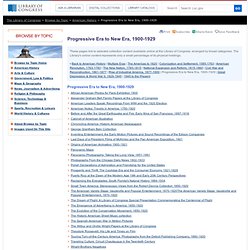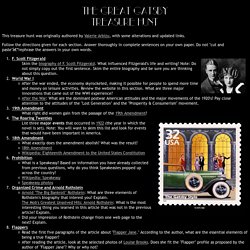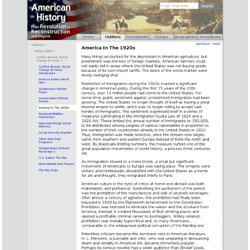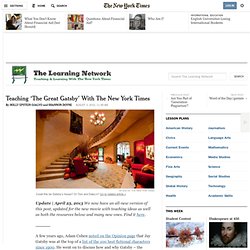

Great Gatsby Digital Storytelling. How and Why We Read: Crash Course English Literature #1. Recovered - Zelda Fitzgerald Photo (9748119) American Masters F. Scott Fitzgerald Winter Dreams Part 4. Mini BIO - F. Scott Fitgerald. F. Scott Fitzgerald Reads Shakespeare. 1920's Party - Dancing at the Famous Tower Ballroom. To Live In The 1920's. Browse by Topic (Library of Congress) - American History - Progressive Era to New Era, 1900-1929. These pages link to selected collection content available online at the Library of Congress, arranged by broad categories.

The Library's online content represents only a small percentage of its physical holdings. Back to American History | Multiple Eras | The Americas to 1620 | Colonization and Settlement, 1585-1763 | American Revolution, 1763-1783 | The New Nation, 1783-1815 | National Expansion and Reform, 1815-1860 | Civil War and Reconstruction, 1861-1877 | Rise of Industrial America, 1877-1900 | Progressive Era to New Era, 1900-1929 | Great Depression & World War II, 1929-1945 | 1945 to the Present. Is Nick a Reliable Narrator? The Great Gatsby - Setting - Book Drum. West and East Egg (Long Island, NY) West and East Egg, on the northern shore of Long Island, are thought to be disguised versions of Great Neck and Manor Haven/Sands Point, both famous in the Jazz Age for wealth and luxury.

Far enough outside the bustle of New York City, here the wealthy could have their space and waterfront views. By and by came the nouveau riche, which is quintessentially what Gatsby represents to Tom. So while Tom and Daisy live on the fashionable, old money east side of the Long Island Sound, Gatsby lives across the bay. New York City Although as decadent, fast and urban in 1922 as it is in the modern context, New York City in Gatsby is a secondary setting. New York City also represents a version of the American Dream.
Valley of Ashes Map Data Map data ©2015 Google Map Louisville, Kentucky. The Great Gatsby; Symbols and Motifs. Great Gatsby Treasure Hunt. This treasure hunt was originally authored by Valerie Arbizu, with some alterations and updated links.

Follow the directions given for each section. Answer thoroughly in complete sentences on your own paper. Do not "cut and paste"—rephrase the answers in your own words. F. Gatsby Reading Resources. Women in the 20's. America In The 1920s < Conflict Abroad, Social Change At Home < History 1990. Many things accounted for the depression in American agriculture, but preeminent was the loss of foreign markets.

American farmers could not easily sell in areas where the United States was not buying goods because of its own import tariffs. Study Guides. Unit Guide - Chapter Questions. The Great Gatsby. The Great Gatsby (1974) - Original Motion Picture Soundtrack. The Great Gatsby (1949) part 4. The Great Gatsby (1949) part 1. The Great Gatsby: Living the Dream in the Valley of Ashes. Like Pale Gold - The Great Gatsby Part I: Crash Course English Literature #4. Teaching 'The Great Gatsby' With The New York Times. Update | April 25, 2013 We now have an all-new version of this post, updated for the new movie with teaching ideas as well as both the resources below and many new ones.

Find it here. A few years ago, Adam Cohen noted on the Opinion page that Jay Gatsby was at the top of a list of the 100 best fictional characters since 1900. He went on to discuss how and why Gatsby – the “cynical idealist, who embodies America in all its messy glory” – is still relevant, perhaps more than ever. Do your students still relate to Gatsby? Do they recognize America and themselves in his drive for self-improvement, his penchant for self-invention, his devotion to self-discipline? We offer these resources on, and related to, F. Lesson Plans Student Crossword Puzzles Times Topics Resources From NYTimes.com. Www.thedustyshelf.com/1-6/gatsby.php. Return to Current Issue A Lesson in Superficiality: Teaching The Great Gatsby in High School by Rance King It is considered a rite of passage. Pmwiki.php?n=Novels. The Great Gatsby and the American dream. In the New York Times earlier this year, Paul Krugman wrote of an economic effect called "The Great Gatsby curve," a graph that measures fiscal inequality against social mobility and shows that America's marked economic inequality means it has correlatively low social mobility.

In one sense this hardly seems newsworthy, but it is telling that even economists think that F Scott Fitzgerald's masterpiece offers the most resonant (and economical) shorthand for the problems of social mobility, economic inequality and class antagonism that we face today. Nietzsche – whose Genealogy of Morals Fitzgerald greatly admired – called the transformation of class resentment into a moral system "ressentiment"; in America, it is increasingly called the failure of the American dream, a failure now mapped by the "Gatsby curve". "How would you place them? " she exclaimed. "Great ladies, bourgeoises, adventuresses - they are all the same. Suddenly she pointed to an American girl going into the water: